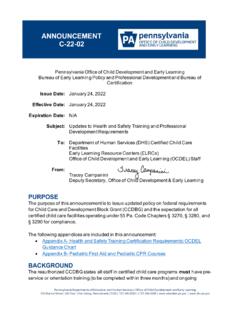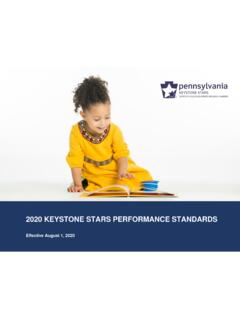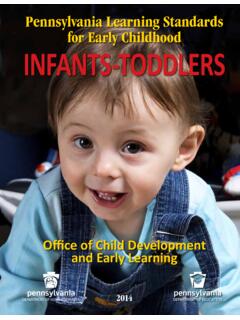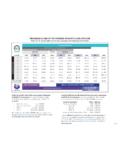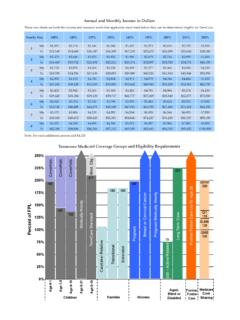Transcription of Pennsylvania Pre-K Counts Statute, Regulations and …
1 Pennsylvania Pre-K Counts Statute, Regulations and Guidelines Effective July 1, 2020 Commonwealth of Pennsylvania Tom Wolf, Governor Department of Education Pedro A. Rivera, Secretary Office of Child Development and Early Learning Tracey Campanini, Deputy Secretary Bureau of Early Learning Policy and Professional Development Kesley Shaw, Director Division of Standards and Professional Development Deborah C. Wise, Chief The Pennsylvania Department of Education (PDE) does not discriminate in its educational programs, activities, or employment practices, based on race, color, national origin, [sex] gender, sexual orientation, disability, age, religion, ancestry, union membership, gender identity or expression, AIDS or HIV status, or any other legally protected category.
2 Announcement of this policy is in accordance with State Law including the Pennsylvania Human Relations Act and with federal law, including Title VI and Title VII of the Civil Rights Act of 1964, Title IX of the Education Amendments of 1972, Section 504 of the Rehabilitation Act of 1973, the Age Discrimination in Employment Act of 1967, and the Americans with Disabilities Act of 1990. The following persons have been designated to handle inquiries regarding the Pennsylvania Department of Education s nondiscrimination policies: For Inquiries Concerning Nondiscrimination in Employment: Pennsylvania Department of Education Equal Employment Opportunity Representative Bureau of Human Resources 333 Market Street, 11th Floor, Harrisburg, PA 17126-0333 Voice Telephone: (717) 787-4417, Fax: (717) 783-9348 For Inquiries Concerning Nondiscrimination in All Other Pennsylvania Department of Education Programs and Activities.
3 Pennsylvania Department of Education School Services Unit Director 333 Market Street, 5th Floor, Harrisburg, PA 17126-0333 Voice Telephone: (717) 783-3750, Fax: (717) 783-6802 If you have any questions about this publication or for additional copies, contact: Pennsylvania Department of Education Office of Child Development and Early Learning 333 Market Street, 6th Floor, Harrisburg, PA 17126-0333 Voice: (717)787-7489, Fax: (717) 787-1529 All Media Requests/Inquiries: Contact the Office of Press & Communications at (717) 783-9802 3 Contents Statutory Authority: .. 5 RULES and Regulations , [22 PA. CODE 405] Pennsylvania Pre-K Counts .
4 6 General Provisions .. 6 Purpose.. 6 6 Guidance and Clarifications .. 8 General rules.. 8 Guidance and Clarifications .. 9 Competitive Application Procedures .. 10 Eligible Provider.. 10 Guidance and Clarifications .. 10 Proposal Submission.. 11 Guidance and Clarifications .. 11 Grant Agreements.. 11 Guidance and Clarifications .. 11 Annual Community Needs Assessment.. 12 Guidance and Clarifications .. 12 Program Planning .. 13 Targeting children to be 13 Guidance and Clarifications .. 13 Maximizing 13 Guidance and Clarifications .. 14 Disallowance of Duplicate Funding.. 14 Guidance and Clarifications.
5 15 15 Guidance and Clarifications .. 15 Program Coordination and Collaboration .. 16 Coordination and Collaboration with Agencies Providing Services to Young 16 Guidance and Clarifications .. 17 Partnerships.. 18 Guidance and Clarifications .. 18 Program and Classroom 19 School Term.. 19 Guidance and Clarifications .. 19 Program Day and Developmentally Appropriate Instructional Practices and Activities.. 19 4 Guidance and Clarifications .. 20 Class Size and Student/Staffing Ratio.. 21 Guidance and Clarifications .. 21 Staffing and Professional 21 Guidance and Clarifications .. 22 Curriculum.. 25 Guidance and Clarifications.
6 25 Assessment.. 25 Guidance and Clarifications .. 26 Parent Involvement.. 27 Guidance and Clarifications .. 27 Program Transition Planning.. 28 Guidance and Clarifications .. 28 29 Guidance and Clarifications .. 29 Emergency Response Plans.. 29 Guidance and Clarifications .. 29 Inclusive Environments.. 30 Guidance and Clarifications .. 30 Recordkeeping, Reporting and Attendance at Department Sponsored Meetings and Trainings .. 31 Program Reporting.. 31 Guidance and Clarifications .. 31 Recordkeeping.. 31 Guidance and Clarifications .. 31 Attendance at Department Sponsored Meetings and Trainings.. 32 Guidance and Clarifications.
7 32 Teacher Induction Plans and Evaluations.. 32 Guidance and Clarifications .. 32 Grantee Fiscal Responsibilities .. 33 Segregation of Funds.. 33 Guidance and Clarifications .. 33 Grant Awards.. 33 Guidance and Clarifications .. 33 Use of Funds.. 33 Guidance and Clarifications .. 34 Supplemental Resources .. 35 #001: Meals and Snacks in Pennsylvania Pre-K Counts 35 #002: Income and Family Size Verification Guidance .. 38 #003: Program Review and Monitoring .. 40 #004: Additional Risk Factor Guidance .. 43 #005: Enrollment, Attendance and Vacancies .. 45 #006 Definition of Instructional Time .. 49 #007 Staff Recruitment and Retention 51 5 #008: Early Childhood Education and Teacher Certification: Frequently Asked Questions 52 #009: Tracking Activity for Moving ECE Level I Certification to Level II Certification.
8 60 #010: Teacher Certification Evaluation in Community-Based Programs .. 62 #011: Teacher Induction for Community-Based Providers .. 65 #012 Comprehensive Screening .. 67 #013: Assessment of the Learning Environment .. 70 #014: Reporting and Data Requirements .. 72 #015: Continuous Quality Improvement/Best Practices .. 76 #016: Fiscal Reporting and Deadlines .. 82 #017: Audit Requirements .. 85 Statutory Authority: Act 45 of 2007 established the Pennsylvania Pre-K Counts (PA PKC) program as a competitive grant program to expand pre-kindergarten opportunities for eligible students throughout this commonwealth. It authorized the Pennsylvania Department of Education (PDE) to promulgate Regulations and establish guidelines and standards necessary to implement the Program.
9 The Regulations that were promulgated can be found at Part 405 of Title 22 of the Pennsylvania Code. PA PKC serves children who are at least three years of age and younger than the entry age for kindergarten and must be provided free of charge. Grants are awarded through a competitive grant process to school districts, Head Start programs, licensed nursery schools, child care centers and group child care homes that are at least a STAR 3 under the Keystone STARS quality rating system established by the Pennsylvania Department of Human Services, and third-party entities that carry out the administrative and fiduciary provisions of PA PKC but not operate a classroom funded by the grant.
10 The PA PKC programs must target enrollment to children who are most at risk of school failure, which is defined as living in households below 300 percent of the federal poverty rate, are English Language Learners (ELL) or are at risk due to community factors, academic difficulties, or economic disadvantage. Grant recipients shall verify income and family size before enrolling students. Children with identifiable disabilities or developmental delays may be included in the program and shall be served in inclusive environments in which they constitute no more than 20 percent of the initial enrollment at the start of the program year. Grant funds may not be placed in a reserve account or used for administrative purposes.
